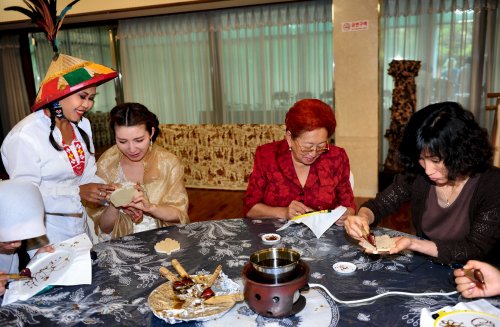From panda to shuttle to ping pong to even Facebook diplomacy, there are many different kinds of diplomatic practices that aim to inform, entertain and bring two nations closer together.
There is now a new form of diplomacy straight from the Indonesian island of Java; one which is so heavily entrenched in their culture that even their president, government officials and sultans wear it on official functions.
“The more that people know about batik the better,” said Indonesian Ambassador Nicholas Dammen to The Korea Herald after hosting a workshop for women from the diplomatic corps and others interested in the age-old art form.
“People know that they can find batik anywhere, like Malaysia, Singapore, Brunei, even in China and everyone claims that batik belongs to them,” he said. “But we want to tell the world that batik is originally from Java and has been recognized by UNESCO as an oral and intangible heritage of Indonesia.”

Nayeon Nuradi (seated left), wife of Indonesia First Secretary Nuradi Noeri, and Lyudmila Fen, doiness of the diplomatic corps and wife of Uzbekistan Ambassador Vitali Fen, learn how to make batik clothing during the Indonesian Embassy’s workshop on the centuries-old dyeing technique. (Wasito Achmad)
Batik is both an art form and a craft, which is becoming more popular and well-known all over the world as a wonderfully creative medium.
The art of decorating cloth in this way has been practiced for centuries and is part of Java history and tradition.
Java is widely recognized to offer some of the finest batik cloth in the world.
In 2009, UNESCO designated Indonesian batik as a Masterpiece of Oral and Intangible Heritage of Humanity and insisted that Indonesia preserve this heritage.
The word batik originates from the Javanese “tik” which means to dot.
Guests at the workshop made their own batik using a piece of cloth and placing it on a wax covered wooden decorated block which was then dyed.
“We are happy to see the ladies gathering and making their own batik here,”
While many diplomatic functions have an extra dimension to them like promoting trade or travel, this workshop was purely to get the word out that batik is Indonesian and is part of their culture.
“I think Korea is not really fond of batik,” said Dammen. “Very rarely I see here in this country people using batik, but at least they know where it comes originally.”
The colors and patterns of batik are as varied as the different cultures found on the Indonesian archipelago.
Batik artists in Yogyakarta and Surakarta on Java Island use traditional colors such as indigo, dark browns and white which represents the three major Hindu gods (Brahma, Shiva and Vishnu).
“In Java, batik is developing into an expression rooted in mythology, philosophy, and the cycle of life. The symbol of Hinduism and Buddhism is reflected beautifully in the traditional batik pattern, while contact with Arabs and Persians brought Islamic nuance,” said Dammen.
Certain patterns can only be worn by nobility with wider strips or wavy lines indicating higher rank.
Furthermore, during Javanese ceremonies, one could determine the royal lineage of a person by the cloth and design of their batik.
Other regions of Indonesia have their own unique patterns incorporating everyday symbols such as flowers, nature, animals, folklore or people.
Batik or fabrics with the traditional batik patterns are found in different parts of Asia like Brunei, Indonesia, Malaysia, Japan, China, India, Sri Lanka and Singapore. It can also be found in other far off areas such as Azerbaijan Egypt, Nigeria and Senegal.
Depending on the quality of the art work, dyes, and fabric, the finest batik cloth can fetch several thousand dollars and take several months to make.
Nowadays, Batik clothes with everyday designs are worn regularly in business and academic settings, while special varieties are incorporated into celebrations of marriage, special occasions, or formal state ceremonies.
“The tradition of making batik carries the wisdom like cascading water of knowledge, from great-grandmothers, to mothers, and to daughters,” he said.
By Yoav Cerralbo (yoav@heraldcorp.com)






